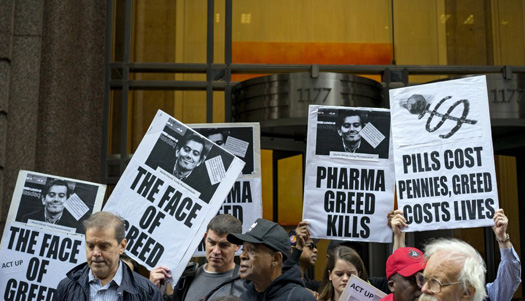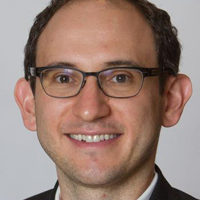
With its scandalous EpiPen price hikes, the Mylan corporation is the latest pharmaceutical company to raise public fury by significantly increasing the price of a life-saving medication. The price of EpiPens, a prefilled syringe with epinephrine that can be easily injected in the event of a life-threatening allergic reaction, has skyrocketed over the past several years. Since 2009, Mylan has gone from charging just over $100 for the device to a whopping $609 today.
In 2015, Martin Shkreli briefly became the nation’s most hated man when his company, Turing Pharmaceuticals, increased the price of pyrimethamine, a 63 year-old medication for toxoplasmosis from $13.50 to $750 per pill.
While overall health care costs went up by 11 percent in the United States from 2013-15, the overall cost of prescription drugs went up by twice that – 20 percent – and now forms 17 percent of total healthcare spending.
The exploding cost of medications is not only a disaster for public insurance programs and state budgets, but also for patients. With more and more people switching to high-deductible plans, people are forced to pay a much higher out-of-pocket cost for medications. This results in poorer adherence to treatment and bad health consequences for people.
How and why is this happening? And, more importantly, what can be done to ensure that everyone has access to life-saving medicines?
Prescription costs are soaring
In the August 23 edition of the Journal of the American Medical Association (JAMA), a group of researchers from Harvard Medical School’s Program On Regulation, Therapeutics, and Law outline some of the causes of prescription drug gouging in the United States.
Our country spends much more on prescription drugs than any other industrialized nation and the pharmaceutical industry is consistently one of the most profitable. According to the BBC, on average, the drug industry had in 2013 almost a 20% profit marginin 2013 – on par with the banking sector and more than twice the average for oil and gas companies.
We spend, per capita, $858 on prescription drugs. Canada is the country that spends the next most, with about $650 per capita. The average for all industrialized countries is $400. Under our private healthcare system, rising drug prices increase premiums of insurance companies (drug prices already constitute 19 percent of private insurance company costs). These soaring premiums push even more people into high deductible plans and make it much harder for unions to negotiate improvements in collective bargaining contracts.
While only 10 percent of dispensed medications are brand-name (vs. generic), they comprise 72 percent of total drug spending. From 2008-15, while the consumer price index rose only 12 percent, brand-name drugs increased by 164 percent! This is due not only to the emergence of expensive new medications, but also because older brand-name drugs have increased in price.
Behind high prices: R&D or monopoly?
Occasionally, there are brand new, innovative medications that result in a significant breakthrough and a high price might be justified. For example, sofosbuvir, a new medication for hepatitis C (marketed under the name Sovaldi by the Gilead corporation), costs $84,000 for a 12-week treatment. However, by curing hepatitis C, this medication not only dramatically reduces human suffering, but also saves much more money in the future by preventing expensive hospitalizations and liver cancer.
But there are very few such first-in-a-class breakthrough medications, even though drug companies often argue that research and development are the main drivers behind the high cost of prescription drugs. In actuality, most of their “new” drugs are not new at all and are only small changes to pre-existing drugs in the market.
Brand-name manufacturers are able to set such a high price because of monopoly practices. When a new medication is approved by the U.S. Food and Drug Administration (FDA), it automatically gets five to twelve years of commercial exclusivity, depending on the type of molecule and the complexity of the manufacturing process.
In addition to FDA exclusivity, manufacturers also enjoy a series of patent protections. Patents for new medications can last more than 20 years. There is no requirement that a new medication has to be better than what is already sold in the market, so drug companies try to extend patents by changing the pill coating, inactive ingredients, and other irrelevant changes. Since most patents are filed before the lengthy 6-8 year development and regulatory approval process, companies can also apply for an additional 5-14 years to “restore” the time that was spent developing and getting approval for the medication.
Once the exclusivity for a medication fully ends, the price dramatically drops as generic manufacturers start producing generic alternatives. Generic companies have to show that their products are 90% bioequivalent to the original medication. How much the price drops depends on the number of generic manufacturers that start producing the drug, the cost of raw materials, complexity of production, and other dynamics.
Companies often engage in shadier practices to extend their exclusivity, such as paying off generic companies to not produce generic forms of the medication, known as “pay-to-delay” deals. Another tactic is to refuse to provide comparison samples to ensure that the generic manufacturer’s product is bioequivalent. These problems are further compounded by the FDA not having sufficient resources to license all the generic manufacturers who have applied to sell medications whose exclusivity has ended. There is now a significant backlog of such applications.
Legal price gouging
Since the passage of the prescription drug benefit program under Medicare (known as Part D), government agencies have paid 40 percent of total prescription drug costs in the United States. A measure was included in the drug benefit law that forbids Medicare and Medicaid from negotiating drug prices with manufacturers.
The U.S. is the only industrialized nation that does not use its public purchasing power to negotiate prices. In every other industrialized country, there are public bodies that evaluate whether the price being asked by the manufacturer reflects the expected benefit of the medication. If the benefit is deemed insufficient for the cost, then the countries can refuse to include the medication in the national healthcare system, forcing the manufacturer to lower its cost if it wants the medication to be included.
In the U.S., no such process happens and drug companies can set their own prices. Some federal agencies, such as the Veterans Administration or the Department of Defense, can attempt to control costs by creating a formulary that excludes expensive brand name meds when generics are available. However, Medicare and Medicaid are forbidden to implement similar programs.
While brand-name drugs explain the majority of the increase in medication prices, there have been a few examples of extreme increases in the price of generic medications as well. While the overall cost of generics has been stable over the last 8 years, approximately 400 medications (2 percent of the total) have increased more than ten-fold.
In addition to Martin Shkreli’s pyrimethamine mentioned above, other examples include: Isoproterenol, a medication used to treat deadly heart-rhythm problems in medical emergencies, increased 25-fold; nitroprusside, a medication for hypertensive emergencies, increased 17-fold; and digoxin, a medication for heart failure, increased about 6-fold.
These are old life-saving medications that increased dramatically in price because their generic manufacturers are the only ones licensed to sell them in the United States and have decided to maximize their profits at the expense of people’s lives.
What is to be done?
Several measures could be taken to reduce and reverse this trend of exploding prescription drug costs. First, the Medicare prescription drug program needs to be amended to allow the federal government to negotiate costs with drug manufacturers, as it does with all other purchased goods and services and as do all other industrialized countries.
Patent and exclusivity laws must be changed to allow patent extensions for drugs only if drug companies demonstrate that the new product is actually new and represents an improvement over other options in the market. Resources should also be dedicated to the FDA to help clear the backlog of license applications for generic companies who want to manufacture and sell generic medications in the U.S.
Reducing the entry barrier for generic companies will help lower the cost of available generic drugs and will reduce the risk of only one company taking control of a medication and engaging in price gouging.
Furthermore, since academic and nonprofit researchers developed a disproportionate share of first-in-a-class breakthrough medications, funding should be provided to promote more research. Publicly-funded research, not expansion of monopoly exclusivity, has been shown to lead to new innovations in drug development.
Lastly, a primary reason people are hurting more from the sky-rocketing price of medications is that more and more people are enrolling in high deductible insurance plans. Defending and strengthening the Affordable Care Act by ensuring that more people can be covered in comprehensive health plans is equally critical as preventing monopolistic behavior in medication manufacturers.
The decision between Hillary Clinton and Donald Trump is one that will determine if the country will continue to pursue rational and progressive reform, as has happened under the Obama administration, or whether it will take a giant step back and completely allow corporations to put profits before people.
Making medications affordable is critical if our society is to ensure quality, affordable health care for all.
Photo: Activists hold signs bearing the image of Turing Pharmaceuticals CEO Martin Shkreli in New York, during a protest on October 1, 2015. | Craig Ruttle/AP












Comments